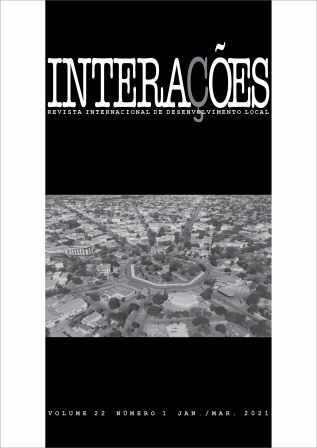The protagonism of indigenous organizations in the structuring of the Brazil nut production chain in the State of Roraima, Brazilian Amazon
DOI:
https://doi.org/10.20435/inter.v22i1.2816Keywords:
Bertholletia excelsa, Wai Wai, Yanomami, indigenous organizationsAbstract
Roraima is the Brazilian state with the lowest Amazon nut production. With an area smaller than other states in the Amazon region and due to the occurrence of the Brazil nut stands restricted to the south-central portion of its territory, the production of this nut in Roraima appears small in official statistics. However, official data ignore the nuts uncontrolled sold to other regions and disregards the economic, social, and historical-cultural importance that this product may have for the hundreds of families living on Brazil nut production in the state. According to a mapping of the Brazil nut production chain in Roraima, it was possible to construct a picture about the situation of its production and marketing in 2013 and 2014, when an articulation was formed in favor of the structuring of this chain in the state, especially regarding the indigenous peoples Wai Wai and Yanomami production. Although the Wai Wai people traded the nut for a longer time, with more support organizations and a more structured chain, both they and the Yanomami had most of this support directed to the nut production. This explains the fact that commercialization has proved to be the weakest link with the highest investment demand. Thus, given the productive potential of the Indigenous Lands and the greater appreciation of the activity and the product itself, the lack of planning for collection and collective sale, as well as the need for investments in outflow and processing infrastructure, are important bottlenecks to the organization of indigenous peoples around Brazil nut production chain in the state of Roraima.
References
ASSOCIAÇÃO DO POVO INDÍGENA ZORÓ. Boas práticas de coleta, armazenamento e comercialização da castanha-do-Brasil: capacitação e intercâmbio de experiências entre os povos da Amazônia mato-grossense com manejo de produtos florestais não-madeireiros. Cuiabá: Defanti, 2010.
BRASIL. Ministério do Desenvolvimento Agrário. Secretaria de Desenvolvimento Territorial. Territórios da cidadania: sul de Roraima − Perfil Territorial. Brasília, DF, 2015. 6 p. Disponível em: http://sit.mda.gov.br/download/caderno/caderno_territorial_091_Sul%20de%20Roraima%20-%20RR.pdf. Acesso em: 13 dez. 2018.
BRASIL. Ministério da Agricultura, Pecuária e Abastecimento. Secretaria de Desenvolvimento Agropecuário e Cooperativismo. Caderno de boas práticas para o extrativismo sustentável orgânico da castanha-do-brasil. Brasília, DF, 2014. 41 p. (Série Boas práticas de manejo para o extrativismo sustentável orgânico). Disponível em: http://www.agricultura.gov.br/assuntos/sustentabilidade/organicos/arquivos-publicacoes-organicos/castanha-do-brasil.pdf. Acesso em: 12 jan. 2019.
BROSE, M. E. Cadeias produtivas sustentáveis no desenvolvimento territorial: a castanha na Bolívia e no Acre, Brasil. Interações, Campo Grande, MS, v. 17, n. 1, p. 77-86, jan./mar. 2016.
GARCÉS, C. L. L.; PÉREZ, S. E. G.; SILVA, J. A.; ARAÚJO, M. O.; COELHO-FERREIRA, M. Objetos indígenas para o mercado: produção, intercâmbio, comércio e suas transformações. Experiências Ka’apor e Mebêngôkre-Kayapó. Boletim do Museu Paraense Emílio Goeldi. Ciências Humanas, Belém, v. 10, n. 3, p. 699-80, set./dez. 2015.
INSTITUTO BRASILEIRO DE GEOGRAFIA E ESTATÍSTICA (Brasil). Produção da extração vegetal e da silvicultura. Rio de Janeiro: IBGE, 2019. Disponível em: https://sidra.ibge.gov.br/tabela/289. Acesso em: 30 out. 2019.
INSTITUTO NACIONAL DE PESQUISAS ESPACIAIS (Brasil).. Programa de Cálculo do Desflorestamento da Amazônia – PRODES. São José dos Campos: INPE, 2015. Disponível em: http://www.dpi.inpe.br/prodesdigital/prodesmunicipal.php. Acesso em: 17 fev. 2018.
INSTITUTO SOCIOAMBIENTAL (Brasil). Terras indígenas no Brasil. Brasília: ISA, 2017. Disponível em: https://terrasindigenas.org.br. Acesso em: 18 dez. 2017.
KAINER, K. A.; WADT, L. H. O.; STAUDHAMMER, C. L. Explaining variation in Brazil nut fruit production. Forest Ecology and Management, Amsterdam, v. 250, n. 3, p. 244-55, out. 2007.
PRANCE, G. T. Bertholletia. In: MORI, S. A.; PRANCE, G. T. (Ed.). Lecythidaceae-Part II: the zygomorphic-flowered new world genera (Couroupita, corythophora, Bertholletia, Couratari, Eschweilera, & Lecythis). New York: New York Botanical Garden, 1990. p. 114-8.
RORAIMA (Estado). Portaria GAB/SEFAZ n. 835, de 3 de novembro de 2015. Altera o Anexo I da SEFAZ/GAB/PORTARIA, de 14 de março de 2012, que dispõe sobre a Pauta de Valores de Preços Mínimos. Diário Oficial [do] Estado de Roraima, Boa Vista, RR, 3 nov. 2015. Disponível em: https://www.legisweb.com.br/legislacao/?id=305735. Acesso em: 8 nov. 2018.
SANTANA, A. C.; SANTANA, Á. L.; SANTANA, Á. L.; MARTINS, C. M. Valoração e sustentabilidade da castanha-do-brasil na Amazônia. Revista de Ciências Agrárias, Belém., v. 60, n. 1, p. 77-89, jan./mar. 2017.
TONINI, H.; LOPES, C. E. V.; KAMINSKI, P. E.; COSTA, P. Perfil do extrativismo e características da cadeia produtiva da castanha-do-brasil em projetos de reforma agrária do sul do Estado de Roraima. Boa Vista: Embrapa Roraima, 2006.
TONINI, H.; BORGES, R. A. O extrativismo da castanha-do-brasil na região do Baixo Rio Branco (RR). Boa Vista: Embrapa Roraima, 2010.
TONINI, H.; LOPES, C. E. V.; ARAUJO, S. L. F. Caracterização do sistema extrativista e coeficientes técnicos de produção para o sistema extrativo da castanheira-do-brasil (Bertholletia excelsa H.B.K) praticado pelos índios Wai Wai em Roraima. Boa Vista: Embrapa Roraima, 2014.
VOGT, P. W. Dictionary of statistics and methodology: a nontechnical guide for the social sciences. London: Sage, 1999.
WADT, L. H. O.; KAINER, K. A.; CARTAXO, C. B. C.; NUNES, G. M.; LEITE, F. M. N.; SOUZA, J. M. L.; GOMES-SILVA, D. A. P.; SOUSA, M. M. M. Manejo da castanheira (Bertholletia excelsa) para produção de castanha-do-brasil. Rio Branco: Seprof, 2005.
WADT, L. H. O.; KAINER, K. A. Domesticação e melhoramento da castanheira. In: BORÉM, A.; LOPES, M. T. G.; CLEMENT, C. R. (Eds.). Domesticação e melhoramento: espécies amazônicas. Viçosa: UFV, 2009. p. 297-317.
ZUIDEMA, P. A.; BOOT, R. Demography of the Brazil nut tree (Bertholletia excelsa) in the Bolivian Amazon: impact of seed extraction on recruitment and population dynamics. Journal of Tropical Ecology. Cambridge, v. 18, n. 1, p. 1-31, abr. 2002.
Downloads
Published
How to Cite
Issue
Section
License
Direitos Autorais para artigos publicados nesta revista são do autor, com direitos de primeira publicação para a revista. Em virtude de aparecerem nesta revista de acesso público, os artigos são de uso gratuito, com atribuições próprias, em aplicações educacionais e não-comerciais.


